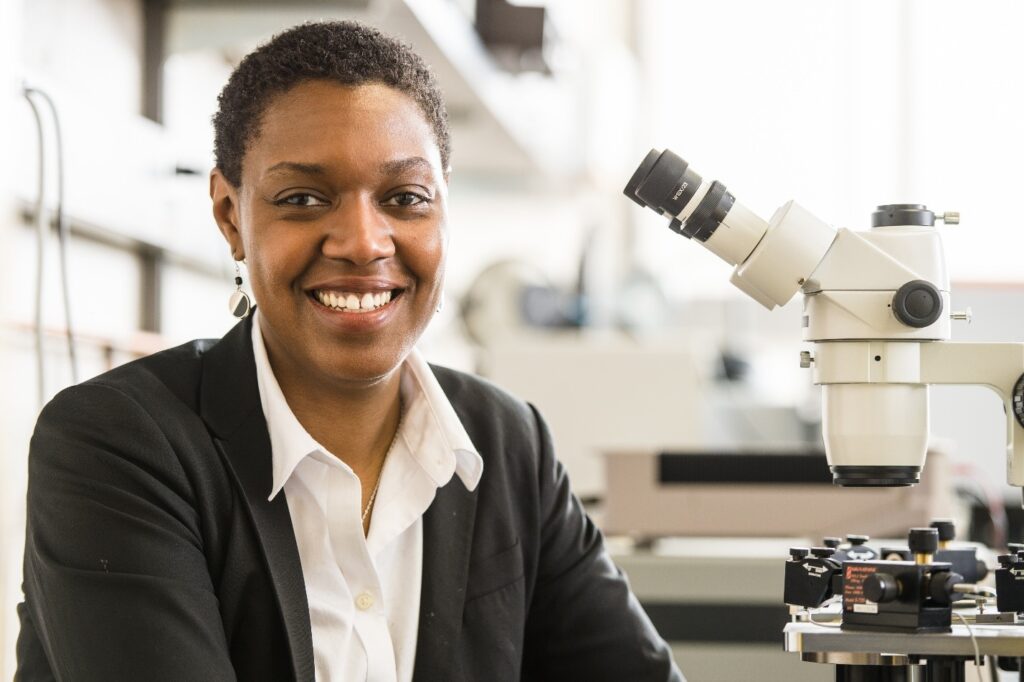 On Rensselaer Polytechnic Institute Week:
On Rensselaer Polytechnic Institute Week:
Shayla Sawyer, professor of electrical, computer, and systems engineering, explores a metal-breathing bacterium dramatically improves biosensors for aquatic ecosystems
Shayla Sawyer is a professor in the Electrical, Computer, and Systems Engineering Department at Rensselaer Polytechnic Institute. Her Nano-Bio Optoelectronics research program expands the fundamental understanding, engineering processes, and potential applications of hybrid inorganic/organic materials for optoelectronic devices and sensors. This includes the fabrication of nanomaterials from bacteria, fabrication in a solution process, and the development of optoelectronic sensors and complimentary systems. The optoelectronic devices are comprised of hybrid inorganic/organic materials what may include semiconductor metal oxide nanostructures, conductive polymers, conductive nanostructures, and bio-chemical solutions. Her overall research goal is aimed at effectively fabricating and characterizing novel materials and sensors with consideration of systems that require sensitivity and/or selectivity to bring quantitative measurements in typically qualitative worlds. NSF Lighting Enabled Systems and Applications Research Center, NSF Divison of Biological Infrastructure, National Security Technologies/Department of Energy, NSF Division on Research and Learning, and the NSF GK-12 Community Situated Research Center are a few recent funding resources for her work.
Improving Biosensors for Ecological Monitoring
Across the globe, freshwater and marine ecosystems are threatened by the effects of multiple, co-occurring environmental pressures including pollutants, invasive species, climate change, acidification, and excess nutrients. Ecologists strive to monitor, understand, and model the effects of excess nutrients, including phosphates and nitrates, in combination with other human threats.
Understanding dynamic spaces with complex and interdependent factors will require a new generation of sensors. Biology-enabled sensors have significant advantages with respect to sensitivity, scalability and selectivity. However, readout and long-range interconnectivity are currently problematic, if not impossible, with biology alone.
Our team is working with a metal-breathing bacterium called Shewanella oneidensis MR1 (S. oneidensis) to try to dramatically improve biosensors for freshwater and marine aquatic ecosystems. Previous research we’ve done demonstrated that, when this unique bacterium “breathes” in certain metal and sulfur compounds anaerobically, it produces nanowires that are capable of transferring electrons. Because their electronic signatures can be mapped and monitored, bacterial biofilms could “collect” data and then connect to — and communicate with — an electronic device.
I am now working with colleagues on the genetic modifications necessary for E. coli to be used in this biosensor. Previously, we worked with S. oneidensis detecting phosphate as a test case. Now, we’re looking at more nutrients that E. coli could target potentially, and introducing it in a larger system. If we can create that interface, than maybe we can measure multiple targets at once.

Comments
4 responses to “Shayla Sawyer, Rensselaer Polytechnic Institute – Improving Biosensors for Ecological Monitoring”